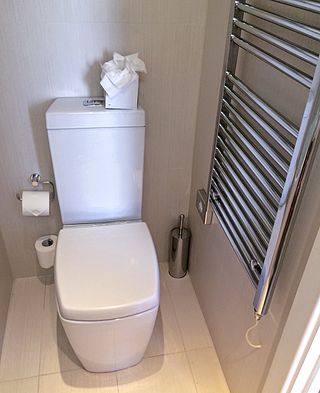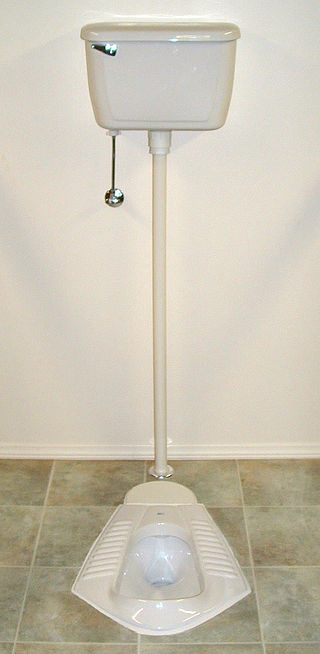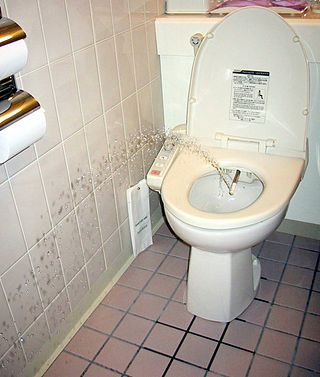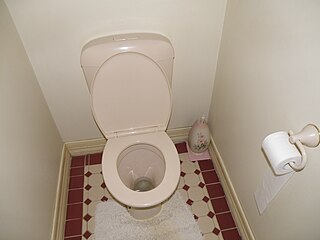
Toilet paper is a tissue paper product primarily used to clean the anus and surrounding region of feces, and to clean the external genitalia and perineal area of urine.

Hygiene is a series of practices performed to preserve health. According to the World Health Organization (WHO), "Hygiene refers to conditions and practices that help to maintain health and prevent the spread of diseases." Personal hygiene refers to maintaining the body's cleanliness. Hygiene activities can be grouped into the following: home and everyday hygiene, personal hygiene, medical hygiene, sleep hygiene and food hygiene. Home and every day hygiene includes hand washing, respiratory hygiene, food hygiene at home, hygiene in the kitchen, hygiene in the bathroom, laundry hygiene and medical hygiene at home.

A flush toilet is a toilet that disposes of human waste by using the force of water to flush it through a drainpipe to another location for treatment, either nearby or at a communal facility, thus maintaining a separation between humans and their waste. Flush toilets can be designed for sitting or squatting, in the case of squat toilets. Most modern sewage treatment systems are also designed to process specially designed toilet paper. The opposite of a flush toilet is a dry toilet, which uses no water for flushing.

Washing is a method of cleaning, usually with water and soap or detergent. Washing and then rinsing both body and clothing is an essential part of good hygiene and health.

A bidet is a bowl or receptacle designed to be sat upon in order to wash one's genitalia, perineum, inner buttocks, and anus. The modern variety has a plumbed-in water supply and a drainage opening, and is thus a plumbing fixture subject to local hygiene regulations. The bidet is designed to promote personal hygiene and is used after defecation, and before and after sexual intercourse. It can also be used to wash feet, with or without filling it up with water. In several European countries, a bidet is now required by law to be present in every bathroom containing a toilet bowl. It was originally located in the bedroom, near the chamber-pot and the marital bed, but in modern times is located near the toilet bowl in the bathroom. Fixtures that combine a toilet seat with a washing facility include the electronic bidet.

A toilet seat is a hinged unit consisting of a round or oval open seat, and usually a lid, which is bolted onto the bowl of a toilet used in a sitting position. The seat can be either for a flush toilet or a dry toilet. A toilet seat consists of the seat itself, which may be contoured for the user to sit on, and the lid, which covers the toilet when it is not in use – the lid may be absent in some cases, particularly in public restrooms.

Hand washing, also known as hand hygiene, is the act of cleaning one's hands with soap or handwash and water to remove viruses/bacteria/microorganisms, dirt, grease, or other harmful and unwanted substances stuck to the hands. Drying of the washed hands is part of the process as wet and moist hands are more easily recontaminated. If soap and water are unavailable, hand sanitizer that is at least 60% (v/v) alcohol in water can be used as long as hands are not visibly excessively dirty or greasy. Hand hygiene is central to preventing the spread of infectious diseases in home and everyday life settings.

A squat toilet is a toilet used by squatting, rather than sitting. This means that the posture for defecation and for female urination is to place one foot on each side of the toilet drain or hole and to squat over it. There are several types of squat toilets, but they all consist essentially of a toilet pan or bowl at floor level. Such a toilet pan is also called a "squatting pan". A squat toilet may use a water seal and therefore be a flush toilet, or it can be without a water seal and therefore be a dry toilet. The term "squat" refers only to the expected defecation posture and not any other aspects of toilet technology, such as whether it is water flushed or not.

Toilets in Japan are sometimes designed more elaborately than toilets commonly seen in other developed nations. European countries often have a toilet and a bidet separate whilst Japan combines an electronic bidet with the toilet. The current state of the art for Western-style toilets in Japan is the bidet toilet, which as of March 2016 is installed in 81% of Japanese households. In Japan, these bidets are commonly called washlets, a brand name of Toto Ltd., and they may include many advanced features rarely seen outside of Asia. The basic feature set commonly found on washlets consists of anal hygiene, bidet washing, seat warming, and deodorization.

Washlet is a line of cleansing toilet seats manufactured and sold by Japanese company Toto. They feature water spray features for genital and anal cleansing. It is an electronic bidet and commonplace on toilets in Japan. Released in June 1980, a total of more than 30 million Washlets had been sold as of January 2011.

A chemical toilet collects human excreta in a holding tank and uses chemicals to minimize odors. They do not require a connection to a water supply and are used in a variety of situations. These toilets are usually, but not always, self-contained and movable. A chemical toilet is structured around a relatively small tank, which needs to be emptied frequently. It is not connected to a hole in the ground, nor to a septic tank, nor is it plumbed into a municipal system leading to a sewage treatment plant. When the tank is emptied, the contents are usually pumped into a sanitary sewer or directly to a treatment plant.

A wet wipe, also known as a wet towel or a moist towelette, disposable wipe, disinfecting wipe, or a baby wipe is a small to medium-sized moistened piece of plastic or cloth that either comes folded and individually wrapped for convenience or, in the case of dispensers, as a large roll with individual wipes that can be torn off. Wet wipes are used for cleaning purposes like personal hygiene and household cleaning; each is a separate product depending on the chemicals added and medical or office cleaning wipes are not intended for skin hygiene.

A space toilet or zero-gravity toilet is a toilet that can be used in a weightless environment. In the absence of weight, the collection and retention of liquid and solid waste is directed by use of airflow. Since the air used to direct the waste is returned to the cabin, it is filtered beforehand to control odor and cleanse bacteria. In older systems, wastewater is vented into space, and any solids are compressed and stored for removal upon landing. More modern systems expose solid waste to vacuum pressures to kill bacteria, which prevents odor problems and kills pathogens.
Anal hygiene or anal cleansing refers to hygienic practices that are performed on a person's anus, usually shortly after defecation. Post-defecation cleansing is rarely discussed academically, partly due to the social taboo. The scientific objective of post-defecation cleansing is to prevent exposure to pathogens while socially it becomes a cultural norm. The process of post-defecation cleansing involves either rinsing the anus and inner part of the buttocks with water or wiping the area with dry materials such as toilet paper. In water-based cleansing, either a hand is used for rubbing the area while rinsing it with the aid of running water or pressurized water is used. In either method subsequent hand sanitization is essential to achieve the ultimate objectives of post-defecation cleansing.
Personal care products are consumer products which are applied on various external parts of the body such as skin, hair, nails, lips, external genital and anal areas, as well as teeth and mucous membrane of the oral cavity, in order to make them clean, protect them from harmful germs and keep them in good condition. They promote personal hygiene and overall health, well-being and appearance of those body parts. Toiletries form a narrower category of personal care products which are used for basic hygiene and cleanliness as a part of a daily routine. Cosmetic products, in contrast, are used for personal grooming and beautification. Pharmaceutical products are not considered personal care products.

A toilet is a piece of sanitary hardware that collects human urine and feces, and sometimes toilet paper, usually for disposal. Flush toilets use water, while dry or non-flush toilets do not. They can be designed for a sitting position popular in Europe and North America with a toilet seat, with additional considerations for those with disabilities, or for a squatting posture more popular in Asia, known as a squat toilet. In urban areas, flush toilets are usually connected to a sewer system; in isolated areas, to a septic tank. The waste is known as blackwater and the combined effluent, including other sources, is sewage. Dry toilets are connected to a pit, removable container, composting chamber, or other storage and treatment device, including urine diversion with a urine-diverting toilet.

A bidet shower—also known as a handheld bidet, commode shower, toilet shower, health faucet, bum shower, shatafa or bum gun—is a hand-held triggered nozzle that is placed near the toilet and delivers a spray of water used for anal cleansing and cleaning of the genitals after using the toilet for defecation and urination, popularised by Arab nations where the bidet shower is a common bathroom accessory. The device is similar to that of a kitchen sink sprayer.

A toilet is a small room used for privately accessing the sanitation fixture (toilet) for urination and defecation. Toilet rooms often include a sink (basin) with soap/handwash for handwashing, as this is important for personal hygiene. These rooms are typically referred to as "half-bathrooms" in a private residence.
An electronic bidet is a seat attached to an existing toilet or a part of the toilet itself, with a nozzle to squirt a jet of warm water for cleaning the anus and female genitals, electrically powered and with electronic controls. It replaces the conventional bidet, a separate plumbing fixture not attached to a toilet. Some bidets of this type have one adjustable nozzle on the side rim for anus and genital areas, or two nozzles on the back rim, a shorter "family nozzle" for washing the area around the anus, and a longer "bidet nozzle" for women to wash their vulva.

The tabò is the traditional hygiene tool primarily for cleansing, bathing, and cleaning the floor of the bathroom in the Philippines, Indonesia, East Timor, Malaysia, Vietnam and Brunei. Tabò is the Filipino name, while gayung and cebok are the equivalent terms used in Indonesia, Brunei, Malaysia, and East Timor. Its Vietnamese name is thau tắm or chậu nước. The tabò could most commonly be found in the provinces though it is also widely used in the cities. The word may be related to the word cebok in neighboring Indonesia and Malaysia, which describes the process of cleansing oneself using a tabò in a mandi.















